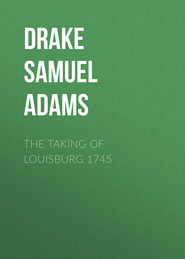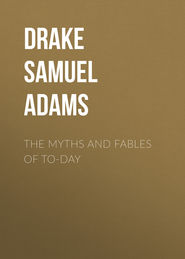По всем вопросам обращайтесь на: info@litportal.ru
(©) 2003-2024.
✖
The Campaign of Trenton 1776-77
Настройки чтения
Размер шрифта
Высота строк
Поля
Up to August 22, the British army made no move from its camps at Staten Island. On their part, the Americans could only watch and wait. On this day, however, active operations began with the landing of Howe's troops, in great force, on the Long Island shore, opposite. This force immediately spread itself out through the neighboring villages from Gravesend, to Flatbush and Flatlands, driving the American skirmishers before them into a range of wooded hills,[1 - This range of hills includes the present Prospect Park and Greenwood Cemetery.] which formed their outer line of defence. Howe had determined to attack in front, clearing the way as he went.
Plan of attack.
As the enemy would have to force his way across these hills, before he could reach the American intrenched lines around Brooklyn, all the roads leading over them were strongly guarded, except out at the extreme left, beyond Bedford village, where only a patrol was posted.[2 - This weak point was the approach from the east where the Jamaica road crossed the hills into Bedford village. By striking this road somewhat higher up, the enemy got to Bedford before the Americans, guarding the hills beyond, had notice of their approach.] This fatal oversight, of which Howe was well informed, suggested the British plan of attack, which was quickly matured and successfully carried out. It included a demonstration on the American left, to draw attention to that point, while another corps was turning the right, at its unguarded point.
A third column was held in readiness to move upon the American centre from Flatbush, just as soon as the other attacks were well in progress. When the flanking corps was in position, these demonstrations were to be turned into real attacks, which, if successful, would throw the Americans back upon the flanking column, which, in its turn, would cut off their retreat to their intrenchments.
This clever combination, showing a perfect knowledge of the ground, worked exactly as planned.
By making a night march, the turning column got quite around the American flank and rear unperceived, and on the morning of the 27th was in position, near Bedford, at an early hour, waiting for the signal-guns to announce the beginning of the battle at the British left.
BATTLE OF LONG ISLAND.
Battle of Long Island.
Both columns then advanced to the attack. Being strongly posted, and well commanded, the Americans made an obstinate resistance and did hold the enemy in check for some hours at one end of the line, only to find themselves cut off by the hurried retreat of all the troops posted at the passes on their left; for as soon as the firing there showed that the turning column had come up in their rear, these troops, with great difficulty, fought their way back to the Brooklyn lines, leaving three generals and upwards of 1,000 men in the enemy's hands.
The resistance met with by the enemy's turning corps may be guessed from what an officer[3 - Captain Harris, of the Fifth Foot.] who took part has to say of it. "We have had," he goes on to relate, "what some call a battle, but if it deserves that name it was the pleasantest I ever heard of, as we had not received more than a dozen shots from the enemy, when they ran away with the utmost precipitation."
Washington re-enforces.
Though not in personal command when the action began, Washington crossed over to Brooklyn in time to see his broken and dispirited battalions come streaming back into their works. Fearing the worst, he had called down two of his best regiments (Shee's and Magaw's) from Harlem Heights, and Glover's from the city, to reënforce the troops then engaged on Long Island, but as has already been pointed out, reënforcing in this manner was out of the question. By making a rapid march, the Harlem troops reached the ferry in the afternoon, after firing had ceased. They were, however, ferried across the next morning.
28th and 29th.
These movements would indicate a resolution to hold the Brooklyn lines at all hazards, and were so regarded, but during the two days subsequent to the battle, while the enemy was closing in upon him, Washington changed his mind, preparations were quietly made to withdraw the troops, while still keeping up a bold front to the enemy, and on the night of the 29th the army repassed the East River without accident or molestation.
Having thus cleared Long Island, the British extended themselves along the East River as far as Newtown, that river thus dividing the hostile camps throughout its whole extent. And though New York now lay quite at his mercy, Howe refrained from cannonading it, for the same reason as Washington did from shelling Boston; namely, that of securing the city intact a little later.
In spite of this brilliant opening of the campaign, and outside of the noisy subalterns who were making their début in war, it was felt that the British army, fresh, numerous, and splendidly equipped, had acquitted itself most ingloriously in permitting the Americans to make their retreat from the island as they had, when the event of an assault must probably have been most disastrous to them.
Losses so far.
On the other side defeat had seriously affected the morale of the Americans. Fifteen hundred men had been lost on Long Island. A great many more were now being lost through desertion. In Washington's own words the unruly militia left him by companies, half regiments or whole regiments, leaving the infection of their evil example to work its will among the well-disposed.
New York to be held.
Although the defence of New York had thus broken down at its vital point, a majority of generals favored still holding the city. To this end Washington now divided his forces, leaving 4,000 in the city, posting 6,500 at Harlem Heights, and 12,000 at Fort Washington and King's Bridge. Though furnished by a general officer,[4 - General Glover's estimate.] these figures really include the sick, who were estimated at nearly 10,000, as well as the large number detached on extra duty. Washington, himself, vaguely estimated his effective force at under 20,000 at this time.
As thus arranged, Harlem Heights, in the centre, became the army headquarters for the time being, Washington, by one of those little accidents that sometimes arrest a passing thought, occupying the house[5 - The Morris House is still standing at 160th street, near 10th avenue, N. Y., and is now occupied by Gen. Ferdinand P. Earle.] of the same lady who had formerly refused the offer of his hand in marriage, Miss Mary Phillipse, later to accept that of Colonel Roger Morris, his old companion in arms during Braddock's fatal campaign.
IV
NEW YORK EVACUATED
Howe seems to have thought that so long as Washington remained in New York he might be bagged at leisure. In no other way can his dilatory proceedings be accounted for. Sixteen days passed without any demonstration on his part whatever. Meantime, however, the steady extension of his lines toward Hell Gate had operated such a change of opinion in the American camp that the decision to hold the city was now reconsidered, and the evacuation fixed for September 15. It was seen that the storm centre was now shifting over toward the American communications, but just where it would break forth was still a matter of conjecture.
Howe was fully informed of what was going on by his royalist friends in the city, and like the cat watching the wounded mouse while it is recovering its breath, he prepared to spring at the moment his enfeebled adversary should show signs of returning animation.
British seize New York.
All being ready, on the very day fixed for the evacuation, Sir Henry Clinton crossed the East River in boats from Newtown Bay to Kipp's Bay, with 4,000 men, landed without opposition, owing to a disgraceful panic which seized the Americans posted there for just such an emergency, and thus thrust himself in between the Americans in the city and those at Harlem Heights. Thus cut off, it was only at the greatest risk of capture that the garrison below was saved, with the loss of much artillery, tents, baggage, and stores, by marching out on one road while the enemy were marching in on another,[1 - A British brigade was sent down to the city in the course of the evening.] as Clinton had immediately pushed on up the island, at the heels of the retreating Americans.
A captain of British grenadiers describes what took place after the landing, in the following animated style:
"After landing in York Island we drove the Americans into their works beyond the eighth milestone from New York, and thus got possession of the best half of the island. We took post opposite to them, placed our pickets, borrowed a sheep, killed, cooked, and ate some of it, and then went to sleep on a gate, which we took the liberty of throwing off its hinges, covering our feet with an American tent, for which we should have cut poles and pitched had it not been so dark. Give me such living as we enjoy at present, such a hut and such company, and I would not care three farthings if we stayed all the winter, for though the mornings and evenings are cold, yet the sun is so hot as to oblige me to put up a blanket as a screen."
Great fire, September 21.
Each side now rested in possession of half the island, Washington of all above Harlem Heights, Howe of all below. His conquest was, however, near proving a barren one, at best, for within a week a third part of the city was laid in ashes, some say by incendiaries, some by accident.
The situation was now so far reversed that Washington seemed to be blockading Howe in the city.
Captain Hale hanged.
Though it had little bearing upon the result of the campaign, one other event is deserving of brief mention here. Clinton's descent had been cleverly managed, out of Washington's sight. What were the enemy proposing to do next? It was imperative to know. To ascertain this Capt. Nathan Hale volunteered to go over to Long Island. At his returning he was arrested. The papers found upon him betrayed his purpose in going within the enemy's lines, and he was forthwith hanged in a manner that would have disgraced Tyburn itself.
Howe's next move was probably conceived with the twofold design, first of cooping Washington up within the island, and second of capturing or breaking up his entire army.
Howe's delays.
But again and again we are puzzled to account for Howe's delays. Hard fighter that he unquestionably was, he seemed never in a hurry to begin. There is even some ground for believing that in New York he had found his Capua. Be that as it may, it is certainly true that nearly a whole month passed by before the sluggard Sir William again drew sword.
Lands at Throg's Neck.
Leaving Lord Percy to defend the lines below Harlem with four brigades, at eight o'clock P.M. of the 11th of October, General Clinton with the reserves, light infantry and 1,500 Hessians, embarked on the East River, passed through Hell Gate, and landed at Throg's Neck,[2 - A contraction of Throgmorton's Neck. As this was an island at high tide, the Americans quickly barred the passage to the mainland by breaking down the bridge.] in Westchester, early the next morning.
STORMING OF FORT WASHINGTON.
Explanation – E, American positions; A-C, British attacks by Harlem River; B, via King's Bridge; D, from Harlem Plains.
Washington moves to White Plains.
Here he lay inactive for six whole days, within six miles of the road on which Washington was moving out from King's Bridge to White Plains; for at the first notice given him of the enemy's movements, which indeed had all along been anxiously expected, Washington had been drawing out his forces from Harlem to King's Bridge, first sending forward some light troops to delay Howe as much as possible, until the army could get into position. It is evident that but for Howe's delays this purpose could not have been successfully accomplished.[3 - On account of the want of wagons this was very slowly done, as the wagons had to be unloaded and sent back for what could not be brought along with the troops.]
Howe marches to give battle.
Meantime the enemy had been bringing up reënforcements, and on the 18th, finding the mainland too strongly held at Throg's Neck, for an advance from that point, they made another landing six miles beyond, whence they marched toward New Rochelle. From here they again marched (22d) for White Plains, where Washington was found (27th) drawn up in order of battle behind the Bronx, waiting for them.
Battle of White Plains, October 28.
Here Washington attempted to make a stand, but his right[4 - This rested on Chatterton's Hill, some distance in front of the main line. Not having intrenched, the defenders were overpowered, though not until after making a sharp fight.] being vigorously attacked and turned, he was forced to fall back upon a second position, in which he remained unmolested for several days, when (November 1) he moved still farther back, to the heights of North Castle, where he felt himself quite safe from attack.
Howe had now manœuvred Washington out of all his defences except Fort Washington, which by General Greene's advice was to be defended, though now cut off from all support.
Fort Washington taken.
Things remained in this situation until November 16, when the fort was assaulted on three sides, with the result that the whole garrison of about 3,000 men were made prisoners of war.[5 - An excellent account of the operations at Fort Washington will be found in Graydon's Memoirs, p. 197 et seq.] At some points the resistance was obstinate, notably at the north, and again at the east, where one of the attacking divisions attempted to gain the rocky shore back of the Morris House, under Harlem Heights. A British officer,[6 - Lieut. Martin Hunter, of the Fifty-second Foot.] there present, says of it that "before landing the fire of cannon and musketry was so heavy that the sailors quitted their oars and lay down in the bottom of the boats, and had not the soldiers taken the oars and pulled on shore we must have remained in this situation."











